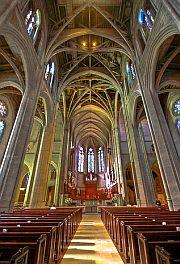
Going back in history to their pre-Anglican, Roman Catholic roots, they will be singing Palestrina, Monteverdi, Gabrieli, and Allegri at St. Mark’s in Venice; San Vitale in Ravenna; San Lorenzo in Florence; and both the Basilica and the Sistine Chapel in Rome — all sites in which this music was originally performed. The tour will provide a wonderful opportunity to compare the sound in Grace Cathedral atop San Francisco’s Nob Hill with that of the venues for which the music was written. (Perhaps Choir Director Jeffrey Smith can send a report to [email protected] when he gets back.)
The echo in Grace Cathedral creates a great wash of sound, and the sound was lovely. But it also blurs words and musical details. In this acoustic, the pieces that juxtapose sections of the chorus in call-and-response blocs are more successful than complex polyphony. Monteverdi fared well, in his lively Cantate Domino. His Beatus Vir was vintage Monteverdi, repeating short motifs in varying harmonic and ornamental contexts, with the opening phrase serving as a kind of rondo.
Changes of meter, well executed, added interest, and there were occasional bits of word-painting, notably on the word peribit (perish), which literally died away in the vast space. In a program largely performed a cappella, Beatus Vir was an exception, being accompanied by a small organ, powered by a young man pumping the bellows with his arm.
Palestrina’s Tu es Petrus provided nice exchanges between the boys and the men. For two double-choir pieces, by Gabrieli and Allegri, the choir became two secure entities, some distance apart to right and left, alternating the singing of imitative parts back and forth, with passages for both together.
An appealing feature of the program was the inclusion of a 20th-century American hymn from the Episcopalian Hymnal. It is an attractive setting of the famous prayer attributed to St. Francis of Assisi: “Lord, make us servants of your peace.” The English translation, by James Quinn, is set by composer Lee Hastings Bristol Jr.
The choir created a nice contrast in performing the hymn’s five verses: The men sang verse 3 as the boys hummed their parts, and the boys sang verse 4, the men humming; all came together again in the last verse. A highlight of the tour will be the singing of this hymn by the San Francisco choir at St. Francis’ monastery in Assisi.

